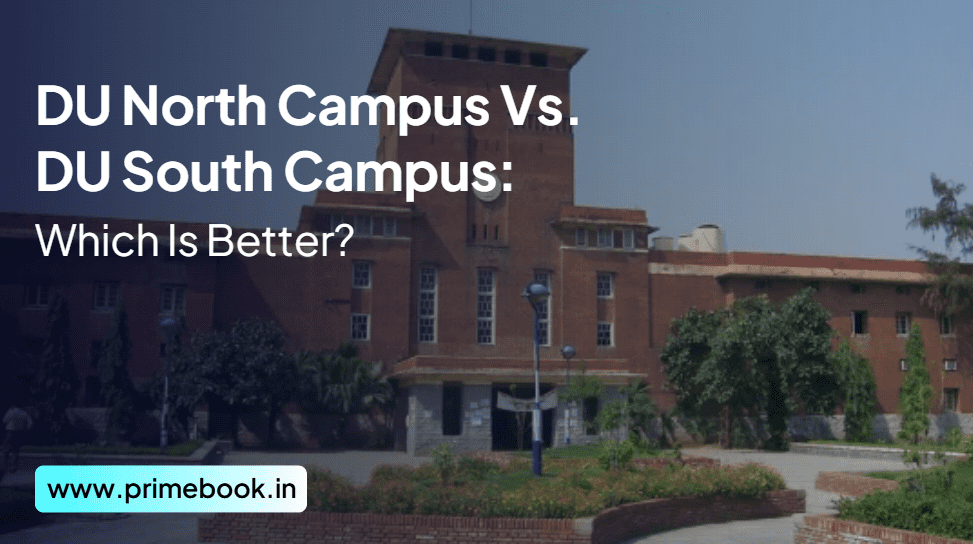Blogs / Student's Corner / DU North Campus Vs. DU South Campus: Which Is Better?
Blogs / Student's Corner / DU North Campus Vs. DU South Campus: Which Is Better?

Primebook Team
09 Aug 2024

DU North Campus Vs. DU South Campus: Which Is Better?
“DU North Campus Vs. DU South Campus: Which is Better?” stands to be one of the most debated and discussed topics for the preexisting students of the university and the aspirants. While some (the foodies) proclaim their North Campus as the better one because of “Tom Uncle Ki Maggi” and “Majnu Ka Theela”, some regard the South Campus as better due to its nearby shopping havens, like Sarojini Market and Lajpat Nagar Market. Students even talk about the cultural vibrancy of the North Campus and the atmospheric serenity of the South Campus when comparing the two. However, in terms of the primary pursuit, i.e., academic quality, both campuses hold firm ground. How? This blog shall guide you through!
Colleges in Delhi University (DU) North Campus
Sprawling over the northern parts of Delhi, the North Campus of Delhi University (DU) houses 16 colleges in total, including the four main colleges that constituted the university's foundation in 1922. Here they go!
|
Name of The Colleges |
Date of Foundation |
NAAC Accreditation |
|
Zakir Husain Delhi College |
1696 |
A |
|
St. Stephen’s College |
1881 |
A |
|
Hindu College |
1899 |
A++ |
|
Ramjas College |
1917 |
A |
|
Indraprastha College for Women |
1924 |
A+ |
|
Shri Ram College of Commerce |
1926 |
A++ |
|
Lady Irwin College |
1928 |
A+ |
|
Hansraj College |
1948 |
A++ |
|
Mirinda House |
1948 |
A++ |
|
Sri Guru Tegh Bahadur Khalsa College |
1951 |
A+ |
|
Kirori Mal College |
1954 |
A++ |
|
Daulat Ram College |
1960 |
A |
|
Shyam Lal College |
1964 |
A++ |
|
Lakshmibai College |
1965 |
B++ |
|
Kalindi College |
1967 |
A |
|
Satyawati College |
1972 |
A+ |
|
Maharaja Agrasen College |
1994 |
A |
DU North Campus also hosts other premier educational centres, such as the Delhi School of Economics, established in 1949, the Ambedkar Center for Biochemical Research in 1991, the Cluster Innovation Centre in 2011, and the Delhi School of Journalism, in 2017.
Colleges in Delhi University (DU) South Campus
Spread over various parts of Southern Delhi, the South Campus of Delhi University (DU) came up as an effort to deal with the demands of university expansion around 1973, and entails some of the renowned colleges! Here are the colleges that, now, are a part of the DU South Campus!
|
Name of The Colleges |
Date of Foundation |
NAAC Accreditation |
|
Lady Sri Ram College |
1956 |
A++ |
|
Pannalal Girdharlal Dayanand Anglo-Vedic College |
1957 |
B |
|
Ramanujan College |
1958 |
A++ |
|
Atma Ram Sanatan Dharma College |
1959 |
A++ |
|
Sri Venkateswara College |
1961 |
A+ |
|
Institute of Home Economics |
1961 |
A |
|
Motilal Nehru College |
1964 |
B |
|
Ram Lal Anand College |
1964 |
B++ |
|
Rajdhani College |
1964 |
B++ |
|
Gargi College |
1967 |
A+ |
|
Maitreyi College |
1967 |
A++ |
|
Jesus and Mary College |
1968 |
A |
|
Sri Aurobindo College |
1972 |
B+ |
|
Aryabhatta College |
1973 |
A+ |
|
Delhi College of Arts and Commerce |
1987 |
B+ |
|
Deen Dayal Upadhyaya College |
1990 |
B |
Main Departments in Delhi University (DU) North Campus & South Campus
Delhi University (DU) offers learning in about 88 disciplines across 15 faculties, such as Arts, Science, Social Sciences, Law, Commerce & Business Studies, Management Studies, Technology, Mathematical Sciences, Medical Sciences, Interdisciplinary & Applied Sciences, Music, and so forth. Different colleges in the North and South Campuses offer different departmental courses under these faculties.
Below are the lists of departments DU holds collectively!
|
Departments Under Arts Faculty |
||
|
Arabic |
Urdu |
English |
|
Hindi |
Persian |
Linguistics |
|
Philosophy |
Psychology |
Sanskrit |
|
Punjabi |
Buddhist Studies |
Library & Information Science |
|
Germanic & Romance Studies |
Modern Indian Languages and Literary Studies |
Slavonic & Finno-Ugrian Studies |
|
Departments Under Science Faculty |
||
|
Botany |
Chemistry |
Anthropology |
|
Geology |
Pharmacy |
Nursing |
|
Environmental Studies |
Home Science |
Physics & Astrophysics |
|
Departments Under the Faculty of Social Sciences |
||
|
History |
Geography |
Economics |
|
Political Science |
Sociology |
Social Work |
|
Journalism |
East Asian Studies |
African Studies |
|
Departments Under the Faculty of Technology |
||
|
Applied Sciences & Humanities |
Architecture & Planning |
Production & Industrial Engineering |
|
Electronics & Computer Engineering |
Civil Engineering |
Instrumentation & Control Engineering |
|
Mechanical Engineering |
Electrical Engineering |
Computer Engineering |
|
Departments Under the Faculty of Medical Sciences |
||
|
Anatomy |
Medical Bio-Chemistry |
Community Medicine |
|
Dental Sciences |
Medicine |
Forensic Medicine |
|
Ophthalmology |
Orthopaedics |
Pathology |
|
Psychiatry |
Pharmacology |
Paediatrics |
|
Physiology |
Radiology |
Surgery |
|
Pulmonary Medicine |
Otolaryngology |
Medical Microbiology |
|
Dermatology, Venereology, & Leprosy |
Obstetrics & Gynaecology |
Anaesthesiology & Critical Care |
|
Departments Under the Faculty of Mathematical Sciences |
|
|
Computer Science |
Mathematics |
|
Operational Research |
Statistics |
|
Departments Under the Faculty of Interdisciplinary & Applied Sciences |
|
|
Biochemistry |
Genetics |
|
Biophysics |
Microbiology |
|
Plant Molecular Biology |
Physical Education & Sports Science |
|
Departments Under the Faculty of Management Studies |
|
|
Business Management & Industrial Administration |
|
Departments Under the Faculty of Applied Social Sciences & Humanities |
|
|
Finance & Business Economics |
|
Departments Under the Music Faculty |
|
|
Music |
Fine Arts |
DU North Campus Vs. DU South Campus: Differences!
While the main difference between DU North Campus and South Campus lies in their geographical location and years of establishment, it can’t be denied the colleges in the North Campus hold greater NAAC accreditation grades and rankings than those of the South Campus, and therefore, the cut-off for aspiring students in the North Campus Colleges go as high as 97.75% to 99.75%. Of course, this doesn’t make the colleges of South Campus unworthy to study from, given that many colleges there have acquired an A++ NAAC rating lately.
To sum up, both campuses have their unique architectural, geographical, and cultural characteristics; both encompass high-quality academic practice. Both offer state-of-the-art educational infrastructure and placement facilities for the students. On both campuses, there are societies, clubs, and various socio-cultural events conducted to stimulate students’ intellectual growth. Hence, determining which between North Campus and South Campus is better will always depend on your individual academic needs and other socio-cultural preferences.


 Related Blog
Related Blog









